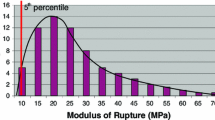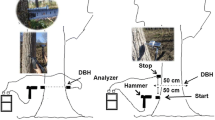Abstract
The objective of this study was to obtain basic knowledge for the prediction of the mechanical properties of Japanese larch lumber (Larix kaempferi) on the basis of tree properties, such as the stress-wave velocity (SWV) and Pilodyn penetration value (Py). The values of the correlation coefficient between the SWV of a standing tree and the dynamic Young’s modulus (DMOE) of logs, which were obtained at various heights, gradually decreased with an increase in the log sampling height, indicating that the SWV of a tree is affected by wood properties at the measuring position. A significant correlation between the SWV of trees and the average modulus of elasticity (MOE) of lumber was found (r =0.834). A significant negative correlation between the Py of a tree and the average modulus of rupture (MOR) of lumber was also found (r=-0.859). A high coefficient of determination for an obtained regression curve was found when both the SWV and Py of a tree were used for evaluating the average MOE or MOR of lumber. These results indicate that the average MOE and MOR of lumber can be predicted by using the SWV and Py of the Japanese larch tree.
Zusammenfassung
Ziel dieser Studie war es, Informationen zur Prognose der mechanischen Eigenschaften von japanischem Lärchenschnittholz (Larix kaempferi) anhand der Ausbreitungsgeschwindigkeit von Spannungswellen (SWV) und der Pilodyn-Eindringtiefe (Py) am stehenden Baum zu gewinnen. Die Korrelationskoeffizienten zwischen der SWV am stehenden Baum und dem dynamischen Elastizitätsmodul (DMOE) von Stammabschnitten nahmen mit zunehmender Entnahmehöhe der Stammabschnitte ab. Daraus geht hervor, dass die am Baum bestimmte SWV von den Holzeigenschaften an der Messstelle beeinflusst wird. Es ergab sich eine signifikante Korrelation zwischen der am Baum bestimmten SWV und dem mittleren Elastizitätsmodul (MOE) von Schnittholz (r=0,834), sowie eine signifikante negative Korrelation zwischen der Pilodyn-Eindringtiefe (Py) am Baum und der mittleren Biegefestigkeit (MOR) des Schnittholzes (r=-0,859). Eine Regressionsrechnung mit den beiden am Baum bestimmten Größen SWV und Py zur Bestimmung des mittleren Elastizitätsmoduls und der Biegefestigkeit von Schnittholz ergab in beiden Fällen ein hohes Bestimmtheitsmaß. Diese Ergebnisse zeigen, dass der mittlere Elastizitätsmodul und die Biegefestigkeit von Schnittholz aus japanischen Lärchen mittels des Stress-Wave- und des Pilodynverfahrens vorhergesagt werden können.
Similar content being viewed by others
References
Carter P, Briggs D, Ross RJ, Wang X (2005) Acoustic testing to enhance western forest values and meet customer wood quality needs. USDA Forest Service General Technical Reports PNW 642:121–129
Ikeda K, Arima T (2000) Quality evaluation of standing trees by a stress-wave propagation method and its application II. Evaluation of sugi stands and application to production of sugi (Cryptomeria japonica D. Don) structural square sawn lumber. Mokuzai Gakkaishi 46:189–196
Ishiguri F, Eizawa J, Saito Y, Iizuka K, Yokota S, Priadi D, Sumiasri N, Yoshizawa N (2007) Variation in the wood properties of Paraserianthes falcataria planted in Indonesia. IAWA J 28:339–348
Ishiguri F, Eizawa J, Saito Y, Iizuka K, Yokota S, Yoshizawa N (2006a) Comparison of wood properties of hinoki (Chamaecyparis obtusa) small diameter logs collected from different tree ages and heights. Mokuzai Gakkaishi 52:383–388
Ishiguri F, Kasai S, Yokota S, Iizuka K, Yoshizawa N (2005) Wood quality of sugi (Cryptomeria japonica) grown at four initial spacings. IAWA J 26:375–386
Ishiguri F, Kawashima M, Iizuka K, Yokota S, Yoshizawa N (2006b) Relationship between stress-wave velocity of standing tree and wood quality in 27-year-old Hinoki (Chamaecyparis obtusa Endl.). J Soc Mat Sci Japan 55:576–582
Koizumi A, Takada K, Ueda K, Katayose T (1990) Radial growth and wood quality of plus trees of Japanese larch I. Radial growth, density, and trunk modulus of elasticity of grafted clones. Mokuzai Gakkaishi 36:98–102
Kollman FFP, Côté WA (1984) Principles of wood science and technology, Volume I: solid wood. Springer-Verlag, Berlin Heidelberg New York Tokyo
Nagao H, Kato H, Kanetsugu Y, Ito T (2000) Estimation of Young’s modulus by combination of stress-wave-transmission time and pilodyn penetration. Abstract of the 50th annual meeting of Japan wood research society. Kyoto, p 109
Nanami N, Nakamura N, Arima T, Okuma M (1992) Measuring the properties of standing trees with stress waves I. The method of measurement and the propagation path of the waves. Mokuzai Gakkaishi 38:739–746
Nanami N, Nakamura N, Arima T, Okuma M (1993) Measuring the properties of standing trees with stress waves III. Evaluating the properties of standing trees for some forest stands. Mokuzai Gakkaishi 39:903–909
Raymond CA, MacDonald AC (1998) Where to shoot your pilodyn: within tree variation in basic density in plantation Eucalyptus globulus and E. nitens in Tasmania. New Forests 15:205–221
Ross RJ, McDonald KA, Green DW, Schad KC (1997) Relationship between log and lumber modulus of elasticity. For Prod J 47(2):89–92
Sprague JR, Talbert JT, Jett JB, Bryant RL (1983) Utility of the pilodyn in selection for mature wood specific gravity in loblolly pine. For Sci 29:696–701
Taylor FW (1981) Rapid determination of Southern pine specific gravity with a pilodyn tester. For Sci 27:59–61
Villeneuve M, Morgenstern EK, Sebastian LP (1987) Estimation of wood density in family tests of jack pine and black spruce using the pilodyn tester. Can J For Res 17:1147–1149
Wagner FG, Gorman TM, Wu SY (2003) Assessment of intensive stress-wave scanning of Douglas-fir trees for predicting lumber MOE. For Prod J 53(3):36–39
Wang X, Ross RJ, McClellan M, Barbour RJ, Erickson JR, Forsman JW, McGinnis GD (2001) Nondestructive evaluation of standing trees with a stress wave method. Wood Fiber Sci 33:522–533
Author information
Authors and Affiliations
Corresponding author
Rights and permissions
About this article
Cite this article
Ishiguri, F., Matsui, R., Iizuka, K. et al. Prediction of the mechanical properties of lumber by stress-wave velocity and Pilodyn penetration of 36-year-old Japanese larch trees . Holz Roh Werkst 66, 275–280 (2008). https://doi.org/10.1007/s00107-008-0251-7
Published:
Issue Date:
DOI: https://doi.org/10.1007/s00107-008-0251-7




